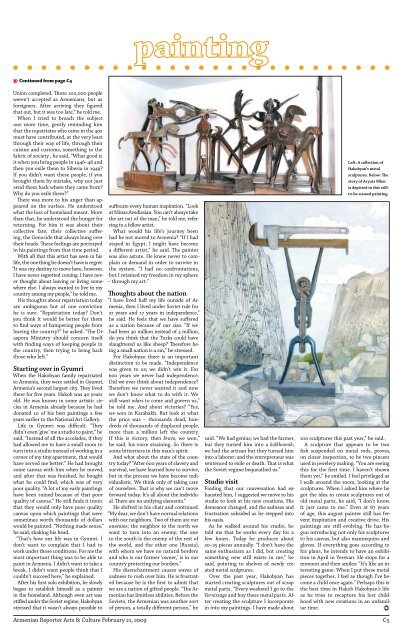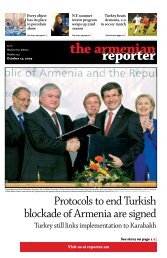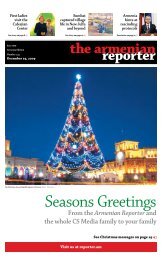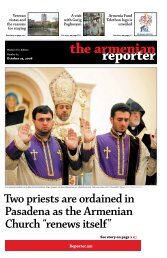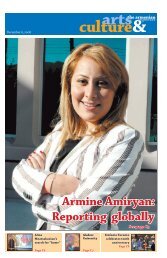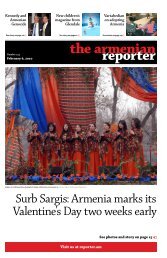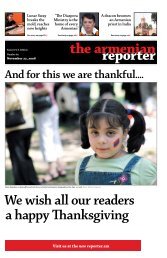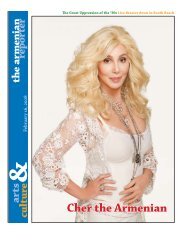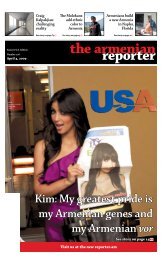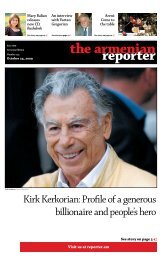You also want an ePaper? Increase the reach of your titles
YUMPU automatically turns print PDFs into web optimized ePapers that Google loves.
n Continued from page C4<br />
Union completed. Those 100,000 people<br />
weren’t accepted as <strong>Armenian</strong>s, but as<br />
foreigners. After arriving they figured<br />
that out, but it was too late,” he told me.<br />
When I tried to broach the subject<br />
one more time, gently reminding him<br />
that the repatriates who came in the 40s<br />
must have contributed, at the very least<br />
through their way of life, through their<br />
cuisine and customs, something to the<br />
fabric of society , he said, “What good is<br />
it when you bring people in 1946–48 and<br />
then you exile them to Siberia in 1949<br />
If you didn’t want these people, if you<br />
brought them by mistake, why not just<br />
send them back where they came from<br />
Why do you exile them”<br />
There was more to his anger than appeared<br />
on the surface. He understood<br />
what the loss of homeland meant. More<br />
than that, he understood the hunger for<br />
returning. For him it was about their<br />
collective fate, their collective suffering,<br />
the Genocide that always hung over<br />
their heads. These feelings are portrayed<br />
in his paintings from that time period.<br />
With all that this artist has seen in his<br />
life, the one thing he doesn’t have is regret.<br />
“It was my destiny to move here, however.<br />
I have never regretted coming. I have never<br />
thought about leaving or living somewhere<br />
else. I always wanted to live in my<br />
country among my people,” he told me.<br />
His thoughts about repatriation today<br />
are ambiguous but of one conviction<br />
he is sure. “Repatriation today Don’t<br />
you think it would be better for them<br />
to find ways of hampering people from<br />
leaving the country” he asked. “The Diaspora<br />
Ministry should concern itself<br />
with finding ways of keeping people in<br />
the country, then trying to bring back<br />
those who left.”<br />
Starting over in Gyumri<br />
When the Hakobyan family repatriated<br />
to Armenia, they were settled in Gyumri,<br />
Armenia’s second largest city. They lived<br />
there for five years. Hakob was 40 years<br />
old. He was known in some artistic circles<br />
in Armenia already because he had<br />
donated 10 of his best paintings a few<br />
years earlier to the National Art Gallery.<br />
Life in Gyumri was difficult. “They<br />
didn’t even ‘give’ me a studio to paint,” he<br />
said. “Instead of all the accolades, if they<br />
had allowed me to have a small room to<br />
turn into a studio instead of working in a<br />
corner of my tiny apartment, that would<br />
have served me better.” He had brought<br />
some canvas with him when he moved,<br />
and after that was finished, he bought<br />
what he could find, which was of very<br />
poor quality. “A lot of my early paintings<br />
have been ruined because of that poor<br />
quality of canvas.” He still finds it ironic<br />
that they would only have poor quality<br />
canvas upon which paintings that were<br />
sometimes worth thousands of dollars<br />
would be painted. “Nothing made sense,”<br />
he said, shaking his head.<br />
“That’s how our life was in Gyumri. I<br />
don’t want to complain that I had to<br />
work under those conditions. For me the<br />
most important thing was to be able to<br />
paint in Armenia. I didn’t want to take a<br />
break. I didn’t want people think that I<br />
couldn’t succeed here,” he explained.<br />
After his first solo exhibition, he slowly<br />
began to establish himself as a painter<br />
in the homeland. Although even art was<br />
stifled under the Soviet regime, Hakobyan<br />
stressed that it wasn’t always possible to<br />
<strong>Armenian</strong> <strong>Reporter</strong> Arts & Culture February 21, 2009<br />
suffocate every human inspiration. “Look<br />
at Minas Avedissian. You can’t always take<br />
the art out of the man,” he told me, referring<br />
to a fellow artist.<br />
What would his life’s journey been<br />
had he not moved to Armenia “If I had<br />
stayed in Egypt, I might have become<br />
a different artist,” he said. The painter<br />
was also astute. He knew never to complain<br />
or demand in order to survive in<br />
the system. “I had no confrontations,<br />
but I retained my freedom in my sphere<br />
– through my art.”<br />
Thoughts about the nation<br />
“I have lived half my life outside of Armenia,<br />
then I lived under Soviet rule for<br />
27 years and 17 years in independence,”<br />
he said. He feels that we have suffered<br />
as a nation because of our size. “If we<br />
had been 30 million instead of 3 million,<br />
do you think that the Turks could have<br />
slaughtered us like sheep Therefore being<br />
a small nation is a sin,” he stressed.<br />
For Hakobyan there is an important<br />
distinction to be made. “Independence<br />
was given to us; we didn’t win it. For<br />
600 years we never had independence.<br />
Did we ever think about independence<br />
Therefore we never wanted it and now<br />
we don’t know what to do with it. We<br />
still want odars to come and govern us,”<br />
he told me. And about victories “Yes,<br />
we won in Karabakh. But look at what<br />
the price was – thousands dead, hundreds<br />
of thousands of displaced people,<br />
more than a million left the country.<br />
If this is victory, then bravo, we won,”<br />
he said, his voice straining. So there is<br />
some bitterness in this man’s spirit.<br />
And what about the state of the country<br />
today “After 600 years of slavery and<br />
survival, we have learned how to survive,<br />
but in the process we have become individualistic.<br />
We think only of taking care<br />
of ourselves. That is why we can’t move<br />
forward today. It’s all about the individual.<br />
There are no unifying elements.”<br />
He shifted in his chair and continued.<br />
“My dear, we don’t have normal relations<br />
with our neighbors. Two of them are our<br />
enemies; the neighbor to the north we<br />
want to turn into an enemy; the one<br />
to the south is the enemy of the rest of<br />
the world, and the other one [Russia],<br />
with whom we have no natural borders<br />
and who is our former ‘owner,’ is in our<br />
country protecting our borders.”<br />
His disenchantment causes waves of<br />
sadness to rush over him. He is frustrated<br />
because he is the first to admit that<br />
we are a nation of gifted people. “The <strong>Armenian</strong><br />
has limitless abilities. Before the<br />
Soviets, the <strong>Armenian</strong> was another sort<br />
of person, a totally different person,” he<br />
said. “We had genius; we had the farmer,<br />
but they turned him into a kolkhoznik;<br />
we had the artisan but they turned him<br />
into a laborer; and the entrepreneur was<br />
sentenced to exile or death. That is what<br />
the Soviet regime bequeathed us.”<br />
Studio visit<br />
Finding that our conversation had exhausted<br />
him, I suggested we move to his<br />
studio to look at his new creations. His<br />
demeanor changed, and the sadness and<br />
frustration subsided as he stepped into<br />
his oasis.<br />
As he walked around his studio, he<br />
told me that he works every day for a<br />
few hours. Today he produces about<br />
20–25 pieces annually. “I don’t have the<br />
same enthusiasm as I did, but creating<br />
something new still exists in me,” he<br />
said, pointing to shelves of newly created<br />
metal sculptures.<br />
Over the past year, Hakobyan has<br />
started creating sculptures out of scrap<br />
metal parts. “Every weekend I go to the<br />
Vernissage and buy these metal parts. After<br />
creating the sculpture I incorporate<br />
in into my paintings. I have made about<br />
Left: A collection of<br />
Hakobyan’s metal<br />
sculptures. Below: The<br />
story of Aryuts Mher<br />
is depicted in this stillto-be-named<br />
painting.<br />
100 sculptures this past year,” he said.<br />
A sculpture that appears to be two<br />
fish suspended on metal rods, proves,<br />
on closer inspection, to be two pincers<br />
used in jewelery making. “You are seeing<br />
this for the first time. I haven’t shown<br />
them yet,” he smiled. I feel privileged as<br />
I walk around the room, looking at the<br />
sculptures. When I asked him where he<br />
got the idea to create sculptures out of<br />
old metal parts, he said, “I don’t know.<br />
It just came to me.” Even at 87 years<br />
of age, this august painter still has fervent<br />
inspiration and creative drive. His<br />
paintings are still evolving. He has begun<br />
introducing not only his sculptures<br />
to his canvas, but also mannequins and<br />
gloves. If everything goes according to<br />
his plans, he intends to have an exhibition<br />
in April in Yerevan. He stops for a<br />
moment and then smiles: “It’s like an interesting<br />
game. When I put these metal<br />
pieces together, I feel as though I’ve become<br />
a child once again.” Perhaps this is<br />
the best time in Hakob Hakobyan’s life<br />
as he tries to recapture his lost childhood<br />
with new creations in an unfamiliar<br />
time.<br />
f<br />
C5


